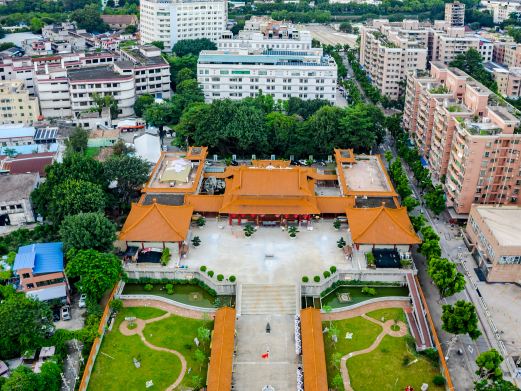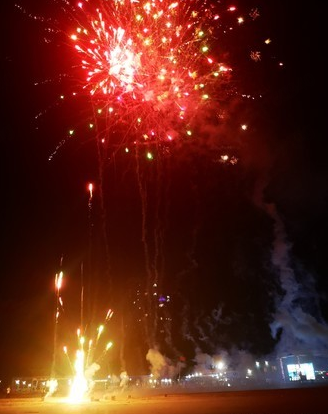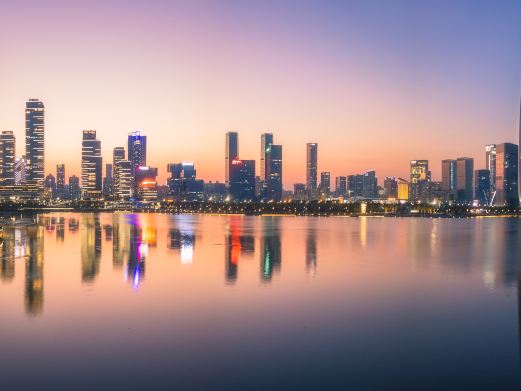The Danzhou Dongpo Cultural Tourism Area is located in the eastern suburb of Zhonghe Town, Danzhou City. It was the place where the great literary master Su Dongpo of the Northern Song Dynasty gave lectures and met friends during his three years in Danzhou. The original site of Zaijiu Hall was the residence of local person Li Ziyun. One day, Su Dongpo visited Li Ziyun together with Zhang Zhong, the envoy of Changhua Army (i.
e., Danzhou), and got together with local people. Everyone proposed that in order to facilitate Su Dongpo’s giving lectures and meeting friends and civilizing the place, a lecture hall should be built at Li Ziyun’s place. Su Dongpo gladly approved and named it ‘Zaijiu Hall’, taking the meaning of ‘carrying wine and food and following to study’ from ‘Biography of Yang Xiong in Hanshu’. According to ‘Records of Zaijiu Hall’ by Xu Zhi, the chief clerk of Danzhou in the Yuan Dynasty, Zaijiu Hall was first built in the fifth year of Shaosheng in the Northern Song Dynasty (1098), that is, more than half a year after Su Dongpo arrived in Danzhou in July of the fourth year of Shaosheng. Since July of the fourth year of Shaosheng in the Northern Song Dynasty (1097), when Su Dongpo was demoted from Huizhou to Danzhou, until the third year of Yuanfu (1100) in June, Su Dongpo was pardoned and returned north. During his three years in Danzhou, the literary master of his generation cultivated the land by himself, painstakingly encouraged farming, changed social traditions, promoted culture and education, and wrote books and established theories, which was respected by the world. At that time, inspired by Su Dongpo’s spirit, the atmosphere of studying and learning culture gradually took shape in Danzhou and even the whole Hainan. Jiang Tangzuo, a scholar from Qiongzhou who was educated by him, became the first person to pass the provincial examination in Hainan in the second year after his return north. And in the ninth year after his return north, Fu Que from Changhua Army (Danzhou) passed the imperial examination and became a successful candidate in the highest imperial examinations. Since then, Hainan ‘broke new ground greatly’ and ended the history of no successful candidates in the highest imperial examinations and became the first successful candidate in the highest imperial examinations in Hainan. Therefore, since ancient times in Hainan, Su Dongpo has been regarded as an important contributor to the cultural development and enlightenment of Hainan. And his enlightening contribution to the culture of Danzhou has been praised for generations. ‘There were scholars in Qiongzhou starting from Danzhou, and there were no more prosperous scholars in Qiongzhou than in Danzhou.’ This is Su Dongpo’s immortal contribution to the cultural development of Danzhou. Today, Dongpo Academy has become a cultural holy land that people from all walks of life and the people of Danzhou look up to for generations. Dongpo Academy was also awarded as a key cultural relic protection unit in 1996 and is one of the important cultural tourism attractions in Hainan. After Dongpo Academy was built in the Northern Song Dynasty, through the Southern Song Dynasty to the early Yuan Dynasty, the hall was abandoned for a long time and there was no record of reconstruction. In the spring of the fifth year of Taiding in the Yuan Dynasty (1328), Peng Yinglei, the deputy magistrate of Danzhou, rebuilt it on the original site. Later, during the Ming and Qing Dynasties and until the early Republic of China, it was reconstructed, added and rebuilt many times. In the 27th year of Jiajing (1548), it was renamed as ‘Dongpo Academy’. Since 1950 when Hainan was liberated, Dongpo Academy in Danzhou has been effectively protected through management and maintenance under the care of successive Party and government leaders. In 1982, it underwent a large-scale renovation and reconstruction, taking on a completely new look. Especially driven by the construction plan of Hainan International Tourism Island, as a cultural relic protection unit, the construction of Dongpo Academy has become one of the key tourism projects in Danzhou City and has achieved greater development in recent years.From 2012 to 2014, the Danzhou Municipal People’s Government undertook extensive repairs on the academy, including the main hall, Zaijiu Hall, two side corridors, side rooms, Zaijiu Pavilion, main gate, lotus pond, railings, Qinshuai Hall, and more. In 2014, a service reception center was added (now changed to Dongpo Fragrance Culture Museum), and relevant tourist service facilities were improved according to star standards.

After generations of repairs and expansions, Dongpo Academy has developed to its current construction scale of 25,040 square meters. The academy houses a main gate, Zaijiu Pavilion, Zaijiu Hall, main hall, side rooms, east and west corridors, exhibition hall, Qinshuai Hall, Huaixian Pavilion, reception service center, Wangjing Pavilion, Dongpo Private School, and other ancient-style buildings.

Inside the academy, there are also attractions such as a bronze statue of Dongpo with a hat and sandals, a sitting bronze statue, a spring ox statue, dog flower, Qinshuai Spring well, and artificial mountains. The academy is lush with plants, adorned with fresh flowers, filled with calligraphy and paintings, and exudes an antique charm, rich in the ‘legacy of Dongpo’.
In 1893 (the nineteenth year of the Guangxu reign), the front gate, veranda, and side rooms were added. In 1934 (the twenty-third year of the Republic of China), it was renovated again, and Dongpo Park and Dongpo Highway (which was a dirt road at that time) were newly built. Since scholars began to give lectures in Zaijiu Hall during the Jiajing period of the Ming Dynasty (1522 – 1566 AD) to carry forward Dongpo’s legacy, it is known as ‘Dongpo Academy’. After the liberation of the whole country, the people’s government has allocated funds for renovation many times. Although it was ‘almost completely destroyed’ during the ‘Cultural Revolution’, from 1983 to 1996, the government successively allocated large sums of money to renovate Zaijiu Pavilion, Pan Pool, the main hall, Zaijiu Hall, the front gate, the east and west corridors, side rooms, Qinshuai Spring, and the academy walls. The construction of the east and west gardens was improved. A bronze statue of Dongpo wearing a bamboo hat and wooden clogs was erected, and an exhibition hall, a welcoming hall, Wangjing Pavilion, and Qinshuai Hall were built. In 1984, a full-time cultural relic protection institution, the Dongpo Academy Management Office, was established to be responsible for the protection, management, and scientific research of Dongpo’s cultural and historical sites. On November 20, 1996, Dongpo Academy was announced as a national key cultural relic protection unit in the fourth batch. Scale of Dongpo Academy: The area within the current walls of Dongpo Academy is 25,040 square meters, and the Dongpo Square in front of the outer front gate is 10.6 mu. Opening hours: Open from 08:30 to 17:30 all year round; open from 18:00 to 22:00 all year round. 1. The daytime performances end at 17:00. It is recommended to enter the park before 16:00. The park is closed and cleared at 17:30. 2. The nighttime performances start at 18:00. The immersive performance ‘Godlike Dongpo’ nighttime shows: 18:00 show, 20:00 show. The performance lasts about 80 minutes. (If there are changes in the performance times and duration, it shall be subject to the on-site notice of the scenic area). Preferential policies: Children: Free for those under 1. 2 meters (inclusive) during the daytime. Elderly: Free for those aged 70 or above (inclusive) with ID cards during the daytime. For those aged 60 (inclusive) to 70 (exclusive), there are preferential policies during the daytime. Active servicemen: Free for those with military officer certificates, soldier certificates or disabled military certificates during the daytime. Disabled people: Free for those with disability certificates during the daytime. College, high school and primary school students: Preferential policies for those with student ID cards or certificates issued by schools during the daytime. Supplementary note: 1. The above information is for reference only. Preferential tickets must be purchased on site. Specific details are subject to the notice of the scenic area. 2. There are no preferential policies for nighttime tickets.









